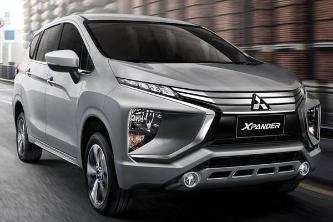br benzene no2
Artikel Terkait br benzene no2

In Brief: 2019 Honda BR-V, if only the Rush/Aruz ride and drive this well
Model | GalleryThe Honda BR-V is a budget seven-seater multi-purpose vehicle (MPV).
In Brief: 2020 Honda BR-V – Most comfortable in the segment, but..
The new 2020 Honda BR-V facelift was recently introduced in Malaysia.
All-new 2022 Honda BR-V to make world debut next week?
rsquo;s product line-up, models that are due for replacement are the Honda Brio, Honda Mobilio, Honda BR-V
New Platinum White Pearl colour for Honda Civic and Honda BR-V
has introduced a brand-new Platinum White Pearl colour option to the 2020 Honda Civic and 2020 Honda BR-V
Honda BR-V – why it’s so much more comfortable than the Perodua Aruz?
The Honda BR-V is already quite far along into its model life.
Second photo of mystery model shown - maybe it's not a new Honda BR-V, but WR-V?
its not the Honda City Hatchback either - thats already been launched in the archipelago.The current BR-V
2020 Mitsubishi Xpander outsells Honda BR-V by more than four times in Thailand
In third place is the Honda BR-V with only 1,163 units sold - 4,428 cars short of the Xpander.That said
Honda Malaysia updates Honda HR-V, BR-V with 360-deg camera - RM 3.3k
Bhd. has released a new accessory for the Honda HR-V and Honda BR-V, which is a 360-degree camera.As
Pros and Cons: Honda BR-V – Still better than the Mitsubishi Xpander?
When Honda Malaysia introduced the Honda BR-V back in 2017, many wondered if this new model is an MPV
Ratings: 2020 Mitsubishi Xpander - A better family car than the Honda BR-V?
the field of budget people-carriers this year is the 2020 Mitsubishi Xpander, challenging the Honda BR-V
2020 Mitsubishi Xpander open for booking in Malaysia: Nov launch, bigger than BR-V and Aruz!
further into the Xpander, heres a quick overview of the Xpander and its closest segment rivals, the Honda BR-V
2020 Mitsubishi Xpander vs Aruz and BR-V – Will it conquer the segment?
The Xpander is assembled in Pekan, The Aruz in Rawang, and the BR-V in Alor Gajah.
Next-gen Honda BR-V, WR-V to be imported from Indonesia to Malaysia?
Malaysia.Although Honda has yet to confirm the model, we think it could either be the next-gen Honda BR-V
Mitsubishi Xpander: Honda BR-V and Perodua Aruz rival, coming soon!
unibody construction.The result is an MPV that offers car-like comfort levels, similar to the Honda BR-V.But
New 2020 Honda BR-V facelift – bookings opened for Malaysia, Q1 2020 launch
Honda Malaysia has opened bookings for the new 2020 BR-V facelift, which is set for a debut within the
Is the Honda BR-V an SUV or an MPV?
The Honda BR-V is an entry-level, three-row seat, seven-seater vehicle.
Ratings: 2020 Honda BR-V 1.5L V - Near-excellent score in Space and Practicality, 162 pts overall
Moving on from the Perodua Aruz from last week, were scrutinizing the 2020 Honda BR-V 1.5L V facelift
Hang on, Honda N7X may not replace BR-V - upscale, bigger 7-seater SUV to debut in August
But in a rather surprise twist, whats touted as the Honda BR-Vs next-gen replacement may not be one at
Video: 2020 Mitsubishi Xpander Review in Malaysia, better choice than the BR-V and Rush?
If you have been looking at B-segment 7-seaters, previously your choice was either the Honda BR-V or
New 2020 Honda BR-V facelift comes with paddle shifters, priced up RM 9k
The 7-seater Honda BR-V receives its first facelift since the model was launched in 2016.
Review Post br benzene no2
@duaduauk @MaChemGuy @nickgreeves Just Googled the Zincke nitration. The mechanism is nucleophilic aromatic substitution - basically same mech as electrophilic except attack on benzene C bonded to Br by NO2- ion so intermediate has a delocalised -ve charge then loss of Br-. Did a lot of SNAr reactions in my PhD!
Review Q&A br benzene no2
Will students of FIITJEE challenge the nomenclature question of the JEE Advanced 2017, as the official answer does not match with FIITJEE?
I am not from fiitjee but i challenged the question. The reason is that the 3rd name 4-methyl chloro benzene is also acceptable according to PRIORITY PREFIX SUBSTITUENT rule According to the rule, halo and alkyl are prefix substituents. List of prefix substituents in PRIORITY ORDER: Azo -N=N- Nitro -NO2 Nitroso -NO Halo -X ( X=F,Cl, Br, I) Alkyl -R. As evident from the table, halo is of greater priority than alky i.e. halo benzene is prioritized as a compound than alkyl benzene. So the given compound can be treated as chloro benzene and methyl can be treated as its substituent instead of treating methyl benzene as the compound and chloro as the substituent. This is an accepted IUPAC nomenclature. Therefore, 4 methyl chlorobenzene is also correct Please challenge the question if you too have suffered deduction of marks due to marking of one additional option. As challenging is free of cost, you only have to spend your time for this.Please don't neglect it.
Can a bromine attached to benzene ring be substitued by NH2 (reacting with NH3 in methanol)?
It’s better that you replace the Br with something more deactivating and replacing that with NO2/ NH2- Replace Br with Li, Li with CO2Li, Then you can go on. Attaching the image, dekh le.:
What are different types of nucleophiles?
Nucleophiles are electron rich compounds/species which attacks at the electron deficient center. Basically Nucleophiles can be categoried as follows: All negatively charge species are nucleophiles. Eg. H-,CH3-,Cl-,NO2-,Br- etc. All compounds containing lone pair of electrons are nucleophiles. Eg. H2O NH3 PH3 PCl3 RNH2 ROH,etc All organometallic,(The compounds in which metals are directly bonded with carbon) ,compounds are nucleophiles. Eg.RMgX(Grignard Reagant),R2CuLi( Gilliman’s Reagant),R2Zn(Frankland Reagant) All polarising functional group are electrophile as well as nucleophile ,(Containg elements of large electronegativity difference). Compounds having pi- electron density are nucleophile. Eg. Alkene,Alkyne,Benzene Ring.
What does it mean by ortho and para directing groups?
Ortho, para-directing groups are groups whose presence in the benzene ring activates it for further electrophilic substitution. The second substitution takes place at the ortho and para (2, 4, 6) positions in relation to the first substituent already present in the ring. Examples of such groups are CH3, OH and NH2 . The halogens Cl, Br and I also show similar tendency. Groups and atoms such as the halogens, NH2 and OH increase the electron density at the ortho and para positions by the +M effect, and the CH3 group by hyperconjugation. So, electrophiles such as Br+, NO2+ or SO3+ attack those electron-rich positions resulting in the formation of ortho and para isomers of the di-substituted benzene derivatives. For instance, nitration of phenol ( C6H5-OH ) with nitric acid yields a mixture of 2-nitrophenol (ortho isomer) and 4-nitrophenol (para isomer). Bromination of aniline ( C6H5-NH2 ) yields 2,4,6-tribromoaniline, as both the two ortho positions and the para position simultaneously get substituted by bromine atoms. Similarly, toluene ( methyl benzene,C6H5-CH3 ) on nitration gives a mixture of 2-nitrotoluene and 4-nitrotoluene.
What is the order of activating and deactivating groups on benzene?
Order of 3 class of groups is Meta directing deactivators< Ortho-Para directing deactivators (halogens) < Ortho -Para directing Activators *Activator -An atom or molecule capable of increasing electron density on benzene ring either by hyper conjugation or by mesomeric effect +R . * Halogen are dectivator due -I effect so their reactivity is less than of benzene but Ortho-Para directing due to +R mesomeric effect. *Deactivates decreases electron density on benzene ring so electrophile can attack on meta position with difficulty. Now the order (Meta directing deactivators) -NO2< -CN < -SO3H < -COCH3 <-COOH < - COOCH3 < -COH < ( OP deactivator) -I < - Br < -Cl < -F < (OP activators ) -H < -ph < -CH3 < -COCH3 < -N(CH3)3 < -OH < -NH2
What do you mean by orientation in the di- and trisubstituted product of benzene?
Orientation and directive influence in mono and di substituted substituted benzene: It talks about the nature of product when substituted benzene undergoes electrophilic substitution reaction. When un substituted benzene undergoes electophilic substitution reaction reaction, all six carbon atoms are equal. So the incoming electrophile can go at any one of the carbon atom. Whereas if mono and di substituted benzene undergoes electrophilic substitution depending upon the group which present in the benzene ring, the incoming electrophile can go either ortho/para or meta position to the the substituent. If electron pumped to the the aromatic pi ring by some means, namely +I, +M effect, the aromatic ring will be activated. In such cases the the relative electron density will be higher at ortho/para than meta position with respect to the substituent. So this type of groups are called ,activating ortho/para directing, groups. Eg. CH3-, C2H5-, OH, -OCH3, -OC2H5, -NH2, -NHR, -NHCOCH3 etc.,( Note: here the rate of substituted benzene is higher than unsubstituted benzene) If the otherway electron withdrawn from the ring by -I or -M effect then the system is said to be deactivated. That is relative electron density at met will be higher than ortho/para. So the incoming electrophile will go and attached at meta position to the existing substituent. So this type of groups are called ,deactivating meta directing, group. Eg. -NO2, -CHO, -COOR, -CN, etc. (,Note:here the rate of substituted benzene is lower than unsubstituted benzene) The third one is ,deactivating ortho/para directing, group/subsituent: Halogens (Cl, Br and I) are coming under this category. Here both -I and +M effects are operating. Due to -I effect of halogen substituent the relative rate (rate of the reaction) of halogen substituted benzene is slower than the reaction of benzene towards electrophilic substitution reaction. So it is said to be ,deactivating,. While the lone pairs present on halogen will be given to pi ring, the incoming electrophile directed to orth/para position with respect to halogen. So it is said ,be ortho/para director,. Hence ,deactivating ortho/para directing. Similarly, if more than one substituent present then, the one which is dominating over other group, will decide the incoming electrophile attachment on the benzene ring. Hope this will clarify your doubt. For more info about Elecrophilic aromatic substitution reaction go through Advanced organic Chemistry by Morrison and Boyd. Thank you.
Why are chlorination, bromination, and nitration of benzene not carried above 50C?
The single substitution of a Cl or a Br or a NO2 group for a hydrogen on benzene is readily accomplished and if the reaction is carried out at higher temperature, more than the desired mono-chloro, mono-bromo or mono-nitro benzene may result. Above some T, the dichloro- or dibromo- benzene product may just leave the mfr with a purification problem, but dinitrobenzene would indicate that trinitrobenzene could be in the mix and TNB is not just a contamination, but is an explosive. Keeping the temperature below some level (OP says 50 C, but I don’t know this independently) makes the process safer, cleaner.
How can ethylene glycol be converted to quinolone?
Convert ethylene glycol to 1,2-dibromoethane. Eliminate 2 HBr molecules to get acetylene, which on heating in presence of iron catalyst trimerizes to benzene. Nitration of benzene to nitrobenzene and reduction will give aniline. Heating aniline with dimethyl acetylene dicarboxylate in presence of CuI, triflic anhydric, triflic acid in dichloroethane solvent at 120 degrees C gives 4-quinolone-2-carboxylic acid methyl ester, which on hydrolysis and decarboxylation gives 4-quinolone. HO-CH2-CH2-OH + PBr3 → Br-CH2-CH2-Br Br-CH2-CH2-Br + KOH → C2H2 → C6H6 C6H6 + HNO3 + H2SO4 → C6H5-NO2 C6H5-NO2 + Fe + HCl → C6H5-NH2 C6H5-NH2 + (MeOOC)2 + catalyst + solvent + heat → 4-quinolone (see structure)
Why does bromobenzene not react in SN1 or SN2?
Because the p-electrons of benzene are in conjugation with the π-electrons of the benzene ring, forming a extended resonance system. Due to this conjugation the C-Br bond has a partial double bond character and is difficult to break i.e. more energy is required to break this bond. SN¹- In SN¹ a carbocation is formed. If you break the C-Br bond then the +ve charge resides on the carbon of the benzene ring making it highly unstable thus it rules out the possibility of SN¹. SN²- In SN² backside attack takes place. Here in case of Bromobenzene the backside attack is blocked by electrons of the benzene ring and the conjugated. Thus, this rules out the possibility of SN² mechanism also. In haloarenes the nucleophilic reactions do occur but only when some highly electronegative group or atom is attached on the benzene ring like -F, -NO2 etc. Mostly the reactions in haloarenes occur by Electrophilic Substitution rather than Nucleophilic.
What are the functions of an electrophile?
The ectrophile is electron lover species. Means which are attracted to electron rich species. That means theelctophiles has electron deficiency. They may be cation of neutral(AlCl3). They play function as Lewis acid. Electrophile has their vacant orbitals. In them they can accept electron pairs. Electrophiles make bond with nucleophile(which is electron rich and can donate them) by accepting the electron pair from them . Don't think the Br- which is added later is electrphile. It is not. Actually the carbon carbon double bond is rich with electron and this nucleophile. When the br2 reaches the alkene the Br closer to the alkene takes on a partial positive charge as it's electrons are repelled by the electron could of the double bond. Thus making the closer molecule a electrophile. This is the electrophile addition. Now have a look in this substitution reaction. Here the No2+ which was genareted in the first reacton is the electrphi. It attacks on the benzene ring and substitution of H+
 Beranda
Beranda 


